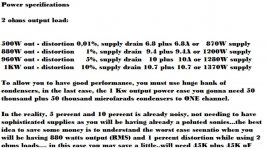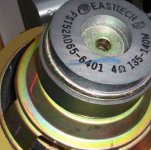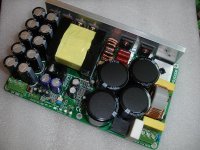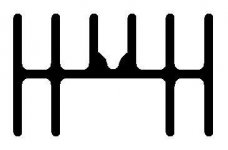Use enameled copper wire.
Choose between 1.0mm diam and 1.6mm diam.
Find a former of between 10mm and 20mm diameter.
Wind on between 8turns and 20turns ..... <snip>.
Hi Andrew,
Perfect! Thanks for your help on the winding as well as placement wrt. the resistor.
Regards,
Francois
It is better to avoid resistor inside the coil..let the coil be air core
resistor inside is not a good idea.
regards,
Carlos
resistor inside is not a good idea.
regards,
Carlos
I'm sorry to bother you,
My transformer is AC 30V ,connect to DX amp, DC is 37.5V.This is my first problem;
The most serious problem is ,when it working,The R6、R12、R13 a little hot,about 60 ℃,then change them 1/2W watt resistance,The problem still exists. (Static current is 90ma.)
I'm new here,Please help me.
Thanks very much.
¡¾Îҵļ×ÒÒÀ๦·Å DX amp Íê³É----¶àͼ¡¿ - ·Å´óÆ÷DIYÂÛ̳ - HIFIDIYÂÛ̳ - Powered by Discuz!
My transformer is AC 30V ,connect to DX amp, DC is 37.5V.This is my first problem;
The most serious problem is ,when it working,The R6、R12、R13 a little hot,about 60 ℃,then change them 1/2W watt resistance,The problem still exists. (Static current is 90ma.)
I'm new here,Please help me.
Thanks very much.
¡¾Îҵļ×ÒÒÀ๦·Å DX amp Íê³É----¶àͼ¡¿ - ·Å´óÆ÷DIYÂÛ̳ - HIFIDIYÂÛ̳ - Powered by Discuz!
What is your amplifier model?
Your forum does not show picture..we have to register and log in to see pictures.
I do not know how to read Chinese languages.... so, unable to register.
People from this forum, that made contact with my amplifiers when and while subscribed to this forum, all them have support and follow up...people that has bough boards from other sources, that have not etched circuit boards by themselves at home, have not support.
There are too many non authorized suppliers of Dx amplifiers, and i do not stimulate nor help this kind of enterprise.
If you are within this condition, then you should find help at your dealer... if not, then send me picture of your home made pcboard and you will have all support.
regards,
Carlos
Your forum does not show picture..we have to register and log in to see pictures.
I do not know how to read Chinese languages.... so, unable to register.
People from this forum, that made contact with my amplifiers when and while subscribed to this forum, all them have support and follow up...people that has bough boards from other sources, that have not etched circuit boards by themselves at home, have not support.
There are too many non authorized suppliers of Dx amplifiers, and i do not stimulate nor help this kind of enterprise.
If you are within this condition, then you should find help at your dealer... if not, then send me picture of your home made pcboard and you will have all support.
regards,
Carlos
Last edited:
Good uncle Charlie ... pretty soon we dance ................🙂
Sergio Mendes + Brasil 66 - MAS QUE NADA - In Stereo! - YouTube
Sergio Mendes + Brasil 66 - MAS QUE NADA - In Stereo! - YouTube
This is the ugly solution I offered you and the thread a year or so ago and you shot me down in flames for daring to suggest a modification to your PCB/schematic/build.a very ugly way to do...but works too...i do prefer to put underneath of the board as no one will see the mess.
About iddle current adjustment, the stand by current
Here you have a video about:
Stand by current adjustment ... ajuste da corrente de repouso - YouTube
Thank you Wayne...the music link.... was good to listen once again....i was young when this music was made.
regards,
Carlos
Here you have a video about:
Stand by current adjustment ... ajuste da corrente de repouso - YouTube
Thank you Wayne...the music link.... was good to listen once again....i was young when this music was made.
regards,
Carlos
Be aware boys...you have now a high power amplifier
I was using my 150 watts Philips speaker and i have increased volume too much...power gone to 600 watts RMS and my speaker started to smell bad.... speake's voice coil resistance dropped to 2.9 ohms because of that.
So..... take care of your speakers...use high power driver units or do not increase too much your volume the way i did.
regards,
Carlos
I was using my 150 watts Philips speaker and i have increased volume too much...power gone to 600 watts RMS and my speaker started to smell bad.... speake's voice coil resistance dropped to 2.9 ohms because of that.
So..... take care of your speakers...use high power driver units or do not increase too much your volume the way i did.
regards,
Carlos
Attachments
Last edited:
Hi Patrick,
I do not know what the latest developments are with a SMPS power supply?
What are the benefits of a SMPS or the important one the comparison SMPS v/s a linear power supply in sound quality.
Rudy
I do not know what the latest developments are with a SMPS power supply?
What are the benefits of a SMPS or the important one the comparison SMPS v/s a linear power supply in sound quality.
Rudy
I've one SMPS in mind at SMPS forum and it's fully tested.What benefits we would have is the price and weight.Some people are saying that a conventional powersupply gives a better sound.Thelaudio claims that the regulation of a regulated powersupply may not be too tight it must have some voltage drop and this way you could use large spicing caps which benefits the sound.When I buy one it would be one of these from Connexelctronics.I must say the one I would build has almost the same layout.
Attachments
The PSU must be able to meet the current demand of the load.
Transformers and smoothing capacitors can survive quite extreme overloading and continue to work without any apparent damage.
An SMPS must be designed to satisfy that same current demand, without suddenly entering some protection regime, because the speaker and the signal demanded more current than the SMPS was designed to supply.
Peak transient current specification must be developed to allow the SMPS to keep up with a transformer + smoothing caps.
Transformers and smoothing capacitors can survive quite extreme overloading and continue to work without any apparent damage.
An SMPS must be designed to satisfy that same current demand, without suddenly entering some protection regime, because the speaker and the signal demanded more current than the SMPS was designed to supply.
Peak transient current specification must be developed to allow the SMPS to keep up with a transformer + smoothing caps.
Still looking for Alex's heatsinks
I already asked this question, but I'll try one more time.
I like the profile for the heatsinks for the MJE15030 and MJE15033 transistors Alex drew in the silkscreen, but can't find them. Does anyone know of such heatsink? If not, what is everyone using?
-Byron
I already asked this question, but I'll try one more time.
I like the profile for the heatsinks for the MJE15030 and MJE15033 transistors Alex drew in the silkscreen, but can't find them. Does anyone know of such heatsink? If not, what is everyone using?
-Byron
Attachments
It's a very nice shape for dissipating heat.
It would be worth searching.
A slight improvement if available would be a slightly thicker web across the middle section. (the bit the To220 bolts to/through).
It would be worth searching.
A slight improvement if available would be a slightly thicker web across the middle section. (the bit the To220 bolts to/through).
I already asked this question, but I'll try one more time.
I like the profile for the heatsinks for the MJE15030 and MJE15033 transistors Alex drew in the silkscreen, but can't find them. Does anyone know of such heatsink? If not, what is everyone using?
-Byron
Here: BGMicro.com - Electronics, Parts, Kits, Components, Projects, Gadgets, DIY - Heatsinks
Thanks everyone. I'll look into those links.
Next question: I just learned about the existence of something called a noise suppression capacitor or EMI suppression capacitor. The various manufacturers claim they are specifically designed for, or especially good at noise suppression. The are more expensive than other comparable caps (e.g. $2.42 compared to $0.94 for a 47nF 250V polypro film). Does anyone know of such creatures? Are they worth it? I was thinking of using them for the 100nF and 47nF condensers between signal and signal ground. I assume the purpose of those caps is to filter noise from the signal ground, no?
-Byron
Next question: I just learned about the existence of something called a noise suppression capacitor or EMI suppression capacitor. The various manufacturers claim they are specifically designed for, or especially good at noise suppression. The are more expensive than other comparable caps (e.g. $2.42 compared to $0.94 for a 47nF 250V polypro film). Does anyone know of such creatures? Are they worth it? I was thinking of using them for the 100nF and 47nF condensers between signal and signal ground. I assume the purpose of those caps is to filter noise from the signal ground, no?
-Byron
- Status
- Not open for further replies.
- Home
- Amplifiers
- Solid State
- Dx Blame MKIII-Hx - Builder's thread





